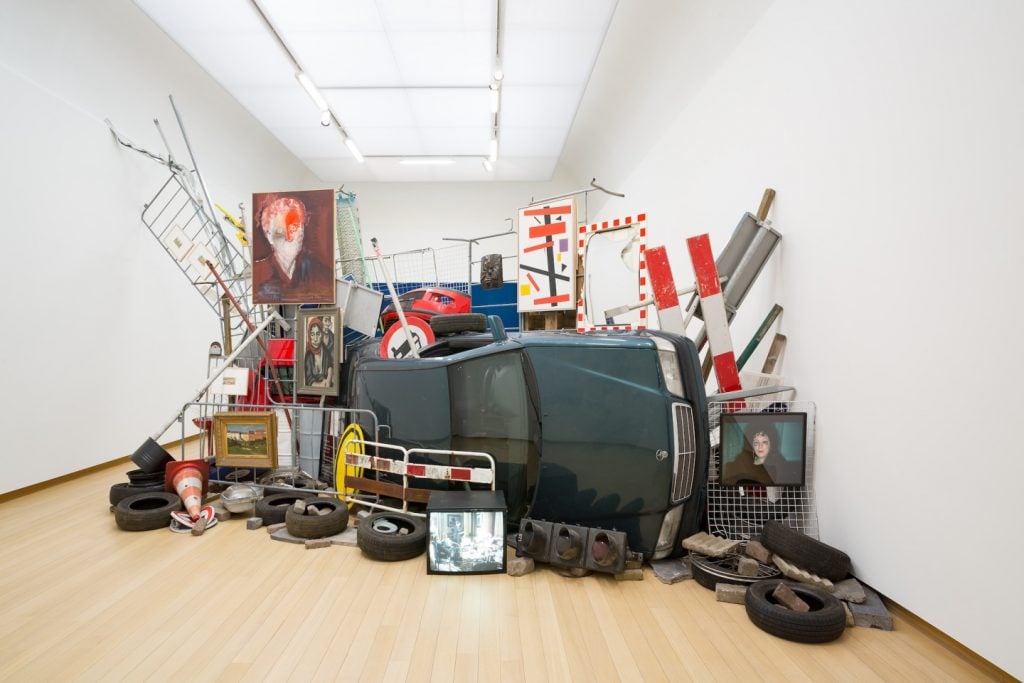Museums & Institutions
Activist Group Tries and Fails to Loan Ahmet Öğüt Installation for Demonstration
An acquisition agreement for the work stipulates it can be loaned for "transformative moments and social movements."

An acquisition agreement for the work stipulates it can be loaned for "transformative moments and social movements."

Adam Schrader

A request by an activist collective to loan an Ahmet Öğüt installation for use in a demonstration has been unsuccessful, after negotiations with Amsterdam’s Stedelijk Museum, which holds the work, fell through. Uniquely, the museum acquired the sculpture with an agreement that stipulates it can be loaned for such purposes.
Öğüt’s installation, titled Bakunin’s Barricade (2015–22), is a sculpture shaped like a blockade, created with found objects and paintings in the museum’s collection. The conceptual artist was inspired by a suggestion from revolutionary anarchist Mikhail Bakunin, who proposed placing paintings from the National Museum in Dresden as a barricade to deter advancing Prussian troops during the 1849 socialist uprising.
Bakunin’s suggestion, though never realized, was based on the assumption that the Prussian troops would not want to destroy cultural treasures. Öğüt has staged site-specific installations at several museums, using works in the collection of each institution. The Stedelijk’s iteration features works by Nan Goldin, Kazimir Malevich, and Käte Kollwitz, among others.
The museum acquired the sculpture in 2020 for the group exhibition “In the Presence of Absence – Proposals for the Museum Collection,” which ran from September 2020 to January 2021. A stipulation in the acquisition contract stated that “the barricade may be requested and deployed during extreme economic, social, political, transformative moments and social movements,” according to Öğüt’s website.
In a statement to Artnet News, the artist said: “Considering the recent uprisings at that time, I aimed to make the contract as realistic as possible, enabling the work to be loaned back to the public and the streets. I pondered how a museum might position itself during future mass protests and wartime, using the Universal Declaration of Human Rights as our foundation.”
He added that Stedelijk’s signing of such an agreement made it “the pioneer museum in accepting the contract’s obligations.”
A group of cultural workers and activists concerned about the effects of Israel’s war in Gaza had submitted a request on May 28 to use Öğüt’s barricade in a demonstration at a school in Amsterdam. Museum officials met with the protest group on June 5 to discuss the request, but the two parties have been unable to see eye-to-eye.
The Stedelijk Museum acknowledged a stand-off over the request in a statement in which it stated the acquisition contract allowed for the institution to loan the work but with replicas of the artworks rather than the originals. It offered to do so to fulfill the request, but the group denied the offer of using reproductions because it would be “too performative,” according to the museum.
Like the protesters, the Stedelijk said it was inspired by the same concerns and planned to show Bakunin’s Barricade at an upcoming exhibition, saying in its statement, “what is happening in Gaza is closely monitored and heavily discussed by all of us at the museum. We too are shocked and saddened by the ongoing violence and loss of so many lives.”
According to the museum, when the loan request was submitted, it was planning the exhibition of Bakunin’s Barricade, as well as a public program where the work will be discussed. The activists were invited to co-design the program, but they declined the invitation.
The Stedelijk Museum was prompted to issue such an in-depth statement because the contract stipulates that the institution has the right to decide on a case-by-case basis and at its discretion whether to honor a request and which works from its collection it wishes to provide, as well as whether they are the original pieces or reproductions. If the museum were to reject a request, it must issue a statement explaining its decision.
“We want to be transparent about our decision-making even though, after all, we didn’t reject the request and thus are not obligated to disclose this,” read the Stedelijk’s statement. “However, out of respect for applicants’ sincere intentions, we decided to do so.”
“From what I have observed, the Stedelijk Museum Amsterdam has adhered to these obligations,” said Öğüt. “However, activists have the right to disagree with the museum’s justification and decline the proposed alternatives.”
The museum added that it was fully aware of the contract when it purchased the work and suggested it never intended to loan original works from its collection because that “clashes with an integral part of our mission and values: to care responsibly for our collection.”
Öğüt, in his statement, added that he still foresees a possibility for the installation to be loaned alongside original works from the museum’s collection in the future.
“In extreme times, when a museum must become a shelter, artworks could serve as a shield alongside protestors to protect fundamental human rights. This doesn’t mean the works are there to be destroyed, but rather respected by all sides as our common cultural heritage,” he said.
“I think it is crucial that, not only as individual cultural workers but also institutionally, we urgently acknowledge the three acts of genocide with requisite intent clearly committed in Gaza, as also stated by UN Human Rights Council experts.”